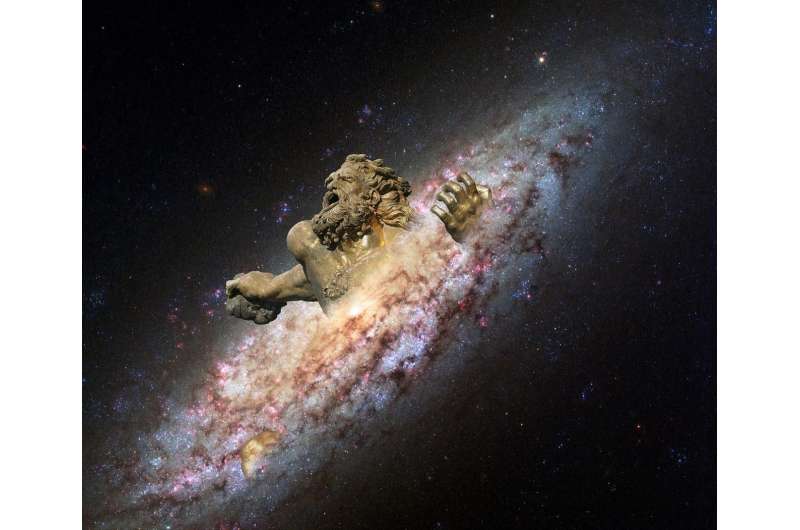Astronomers discover the giant that shaped the early days of our Milky Way

Some 10 billion years ago, the Milky Way merged with a large galaxy. The stars from this partner, named Gaia-Enceladus, make up most of the Milky Way's halo and also shaped its thick disk, giving it its inflated form. A description of this mega-merger, discovered by an international team led by University of Groningen astronomer Amina Helmi, is now published in the scientific journal Nature.
Large galaxies like our Milky Way are the result of mergers of smaller galaxies. An outstanding question is whether a galaxy like the Milky Way is the product of many small mergers or of a few large ones. The University of Groningen's Professor of Astronomy, Amina Helmi has spent most of her career looking for 'fossils' in the Milky Way that might offer some hints as to its evolution. She uses the chemical composition, position and trajectory of stars in the halo to deduce their history, and thereby to identify the mergers that created the early Milky Way.
The recent second data release from the Gaia satellite mission last April provided Professor Helmi with data on around 1.7 billion stars. Helmi has been involved in the development of the Gaia mission for some 20 years, and was part of the data validation team on the second data release. She has now used the data to look for traces of mergers in the halo: "We expected stars from fused satellites in the halo. What we didn't expect to find was that most halo stars actually have a shared origin in one very large merger."
Thick disk
The chemical signature of many halo stars was clearly different from the 'native' Milky Way stars. "And they are a fairly homogenous group, which indicates they share a common origin." By plotting both trajectory and chemical signature, the 'invaders' stood out clearly. Helmi says, "The youngest stars from Gaia-Enceladus are actually younger than the native Milky Way stars in what is now the thick disk region. This means that the progenitor of this thick disk was already present when the fusion happened, and Gaia-Enceladus, because of its large size, shook it and puffed it up."
In a previous paper, Helmi had already described a huge 'blob' of stars sharing a common origin. Now, she shows that stars from this blob in the halo are the debris from the merging of the Milky Way with a galaxy which was slightly more massive than the Small Magellanic Cloud, some 10 billion years ago. The galaxy is called Gaia-Enceladus, after the Giant Enceladus who in Greek mythology was born of Gaia (the Earth goddess) and Uranus (the Sky god).
The data on kinematics, chemistry, age and spatial distribution from the native Milky Way stars and the remnants of Gaia-Enceladus reminded Helmi of simulations performed by a former Ph.D. student, some 10 years ago. His simulations of the merging of a large disc-shaped galaxy with the young Milky Way produced a distribution of stars from both objects, which is totally in line with the Gaia data. "It was amazing to look at the new Gaia data and realize that I had seen it before," says the astronomer.
More information: Amina Helmi et al, The merger that led to the formation of the Milky Way's inner stellar halo and thick disk, Nature (2018). DOI: 10.1038/s41586-018-0625-x
[1] Helmer H. Koppelman, Amina Helmi, Jovan Veljanoski: One large blob and many streams frosting the nearby stellar halo in Gaia DR2. APJ Letters, 12 June 2018, DOI: 10.3847/2041/aac882
Journal information: Nature
Provided by University of Groningen




















